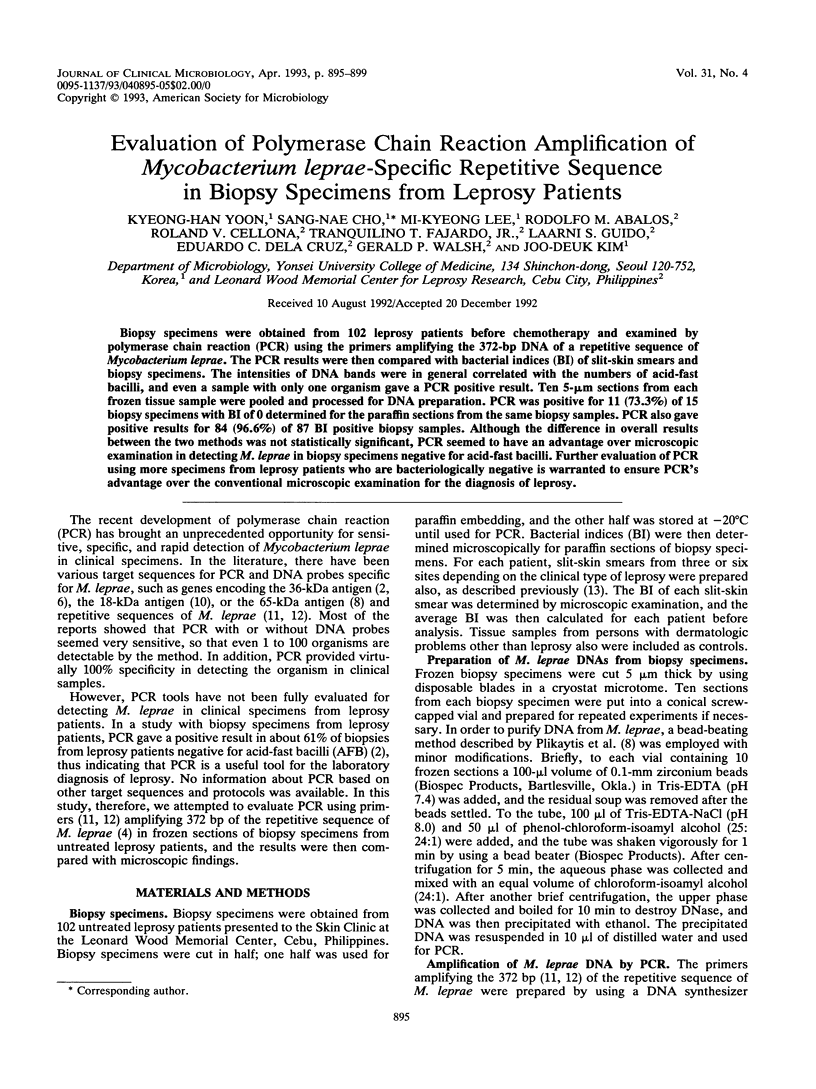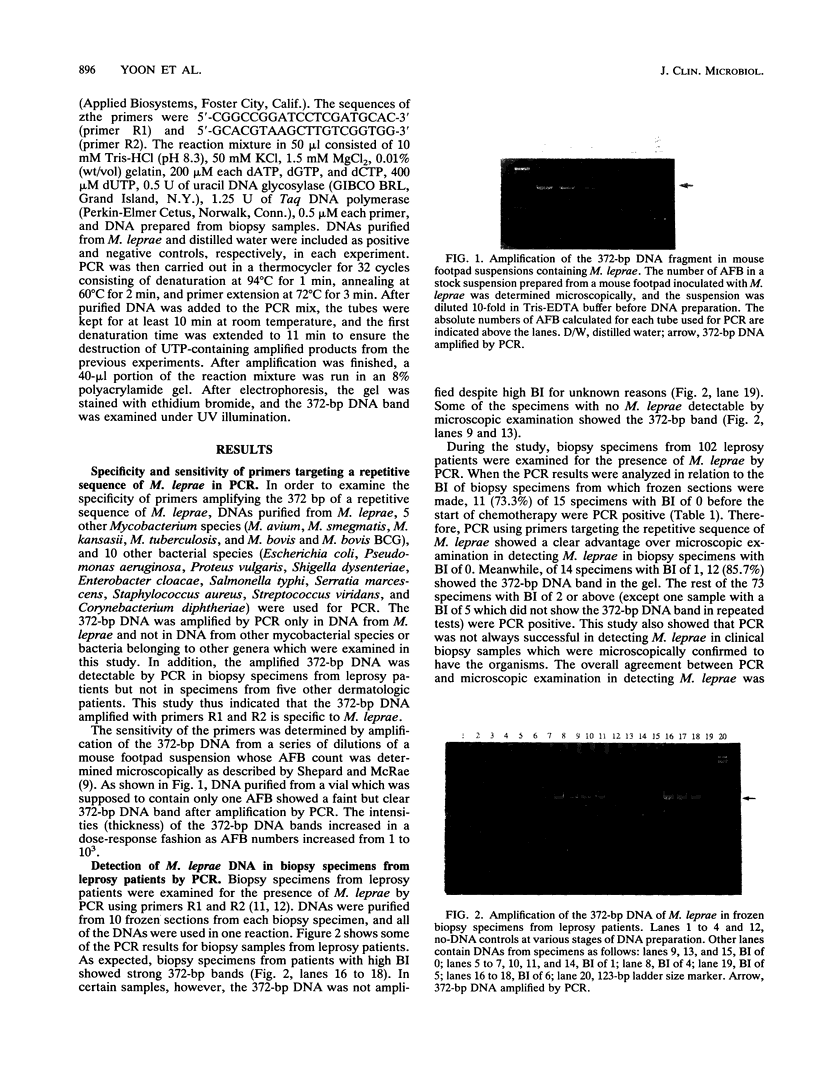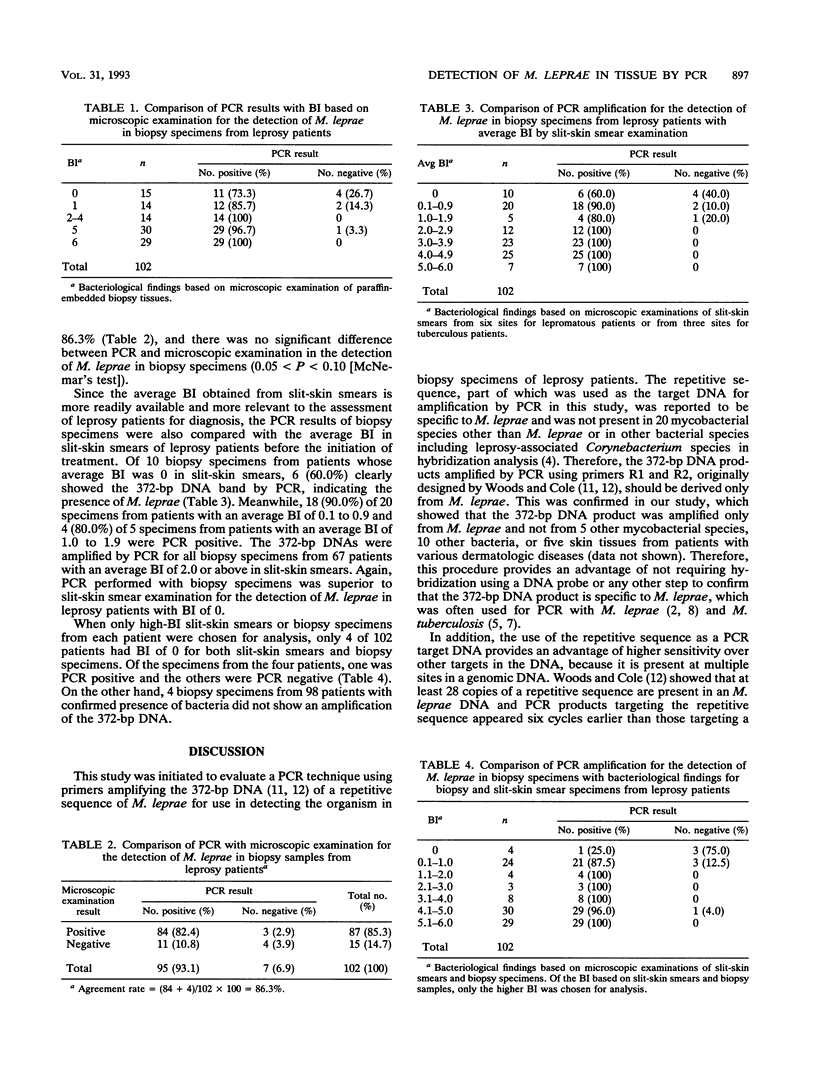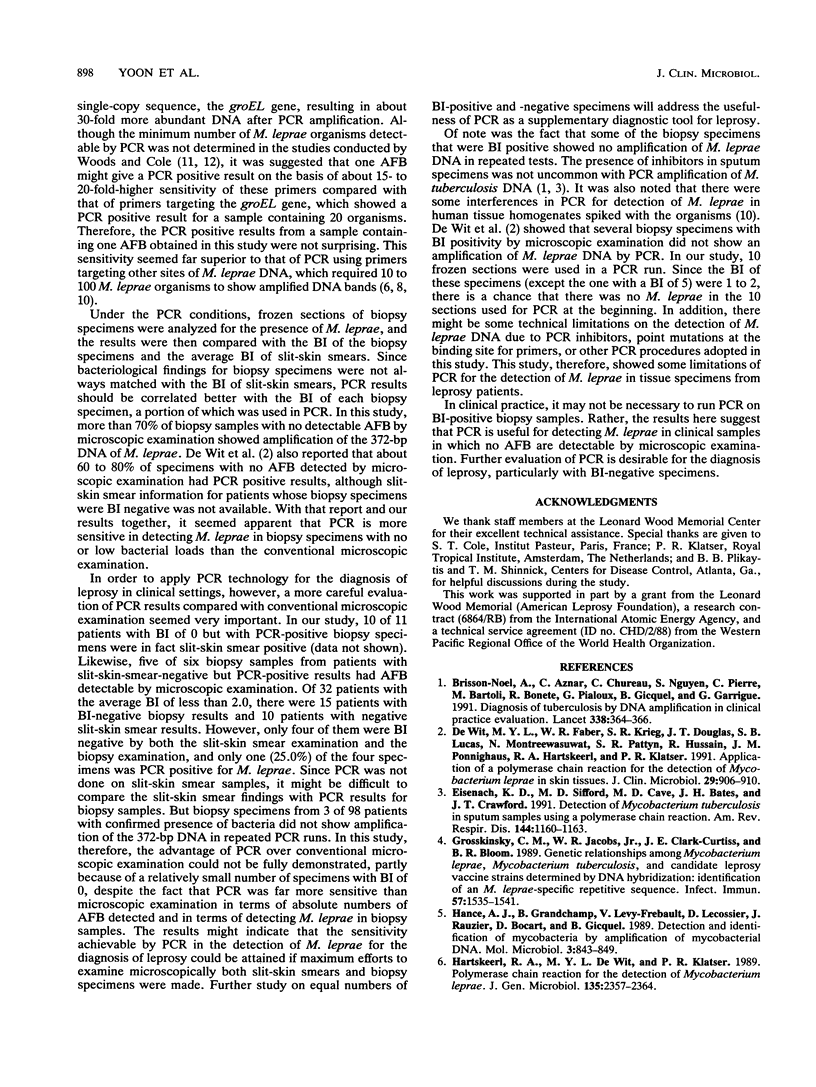Abstract
Biopsy specimens were obtained from 102 leprosy patients before chemotherapy and examined by polymerase chain reaction (PCR) using the primers amplifying the 372-bp DNA of a repetitive sequence of Mycobacterium leprae. The PCR results were then compared with bacterial indices (BI) of slit-skin smears and biopsy specimens. The intensities of DNA bands were in general correlated with the numbers of acid-fast bacilli, and even a sample with only one organism gave a PCR positive result. Ten 5-micron sections from each frozen tissue sample were pooled and processed for DNA preparation. PCR was positive for 11 (73.3%) of 15 biopsy specimens with BI of 0 determined for the paraffin sections from the same biopsy samples. PCR also gave positive results for 84 (96.6%) of 87 BI positive biopsy samples. Although the difference in overall results between the two methods was not statistically significant, PCR seemed to have an advantage over microscopic examination in detecting M. leprae in biopsy specimens negative for acid-fast bacilli. Further evaluation of PCR using more specimens from leprosy patients who are bacteriologically negative is warranted to ensure PCR's advantage over the conventional microscopic examination for the diagnosis of leprosy.
Full text
PDF




Images in this article
Selected References
These references are in PubMed. This may not be the complete list of references from this article.
- Brisson-Noel A., Aznar C., Chureau C., Nguyen S., Pierre C., Bartoli M., Bonete R., Pialoux G., Gicquel B., Garrigue G. Diagnosis of tuberculosis by DNA amplification in clinical practice evaluation. Lancet. 1991 Aug 10;338(8763):364–366. doi: 10.1016/0140-6736(91)90492-8. [DOI] [PubMed] [Google Scholar]
- Eisenach K. D., Sifford M. D., Cave M. D., Bates J. H., Crawford J. T. Detection of Mycobacterium tuberculosis in sputum samples using a polymerase chain reaction. Am Rev Respir Dis. 1991 Nov;144(5):1160–1163. doi: 10.1164/ajrccm/144.5.1160. [DOI] [PubMed] [Google Scholar]
- Grosskinsky C. M., Jacobs W. R., Jr, Clark-Curtiss J. E., Bloom B. R. Genetic relationships among Mycobacterium leprae, Mycobacterium tuberculosis, and candidate leprosy vaccine strains determined by DNA hybridization: identification of an M. leprae-specific repetitive sequence. Infect Immun. 1989 May;57(5):1535–1541. doi: 10.1128/iai.57.5.1535-1541.1989. [DOI] [PMC free article] [PubMed] [Google Scholar]
- Hance A. J., Grandchamp B., Lévy-Frébault V., Lecossier D., Rauzier J., Bocart D., Gicquel B. Detection and identification of mycobacteria by amplification of mycobacterial DNA. Mol Microbiol. 1989 Jul;3(7):843–849. doi: 10.1111/j.1365-2958.1989.tb00233.x. [DOI] [PubMed] [Google Scholar]
- Hartskeerl R. A., de Wit M. Y., Klatser P. R. Polymerase chain reaction for the detection of Mycobacterium leprae. J Gen Microbiol. 1989 Sep;135(9):2357–2364. doi: 10.1099/00221287-135-9-2357. [DOI] [PubMed] [Google Scholar]
- Hermans P. W., Schuitema A. R., Van Soolingen D., Verstynen C. P., Bik E. M., Thole J. E., Kolk A. H., van Embden J. D. Specific detection of Mycobacterium tuberculosis complex strains by polymerase chain reaction. J Clin Microbiol. 1990 Jun;28(6):1204–1213. doi: 10.1128/jcm.28.6.1204-1213.1990. [DOI] [PMC free article] [PubMed] [Google Scholar]
- Plikaytis B. B., Gelber R. H., Shinnick T. M. Rapid and sensitive detection of Mycobacterium leprae using a nested-primer gene amplification assay. J Clin Microbiol. 1990 Sep;28(9):1913–1917. doi: 10.1128/jcm.28.9.1913-1917.1990. [DOI] [PMC free article] [PubMed] [Google Scholar]
- Shepard C. C., McRae D. H. A method for counting acid-fast bacteria. Int J Lepr Other Mycobact Dis. 1968 Jan-Mar;36(1):78–82. [PubMed] [Google Scholar]
- Williams D. L., Gillis T. P., Booth R. J., Looker D., Watson J. D. The use of a specific DNA probe and polymerase chain reaction for the detection of Mycobacterium leprae. J Infect Dis. 1990 Jul;162(1):193–200. doi: 10.1093/infdis/162.1.193. [DOI] [PubMed] [Google Scholar]
- Woods S. A., Cole S. T. A family of dispersed repeats in Mycobacterium leprae. Mol Microbiol. 1990 Oct;4(10):1745–1751. doi: 10.1111/j.1365-2958.1990.tb00552.x. [DOI] [PubMed] [Google Scholar]
- Woods S. A., Cole S. T. A rapid method for the detection of potentially viable Mycobacterium leprae in human biopsies: a novel application of PCR. FEMS Microbiol Lett. 1989 Dec;53(3):305–309. doi: 10.1016/0378-1097(89)90235-8. [DOI] [PubMed] [Google Scholar]
- de Wit M. Y., Faber W. R., Krieg S. R., Douglas J. T., Lucas S. B., Montreewasuwat N., Pattyn S. R., Hussain R., Ponnighaus J. M., Hartskeerl R. A. Application of a polymerase chain reaction for the detection of Mycobacterium leprae in skin tissues. J Clin Microbiol. 1991 May;29(5):906–910. doi: 10.1128/jcm.29.5.906-910.1991. [DOI] [PMC free article] [PubMed] [Google Scholar]




